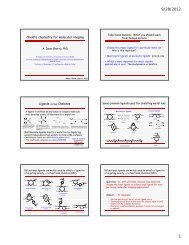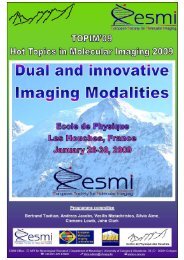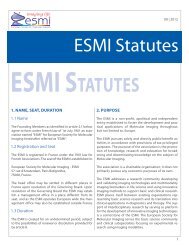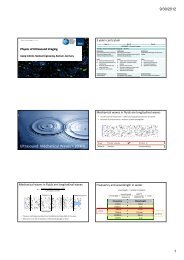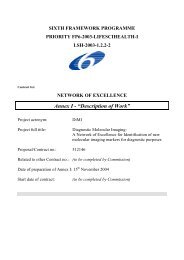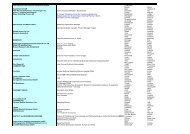5th EuropEan MolEcular IMagIng MEEtIng - ESMI
5th EuropEan MolEcular IMagIng MEEtIng - ESMI
5th EuropEan MolEcular IMagIng MEEtIng - ESMI
You also want an ePaper? Increase the reach of your titles
YUMPU automatically turns print PDFs into web optimized ePapers that Google loves.
<strong>5th</strong> <strong>EuropEan</strong> <strong>MolEcular</strong> <strong>IMagIng</strong> <strong>MEEtIng</strong> – EMIM2010<br />
In-vivo imaging of a mouse traumatic brain injury model using dual-isotope quantitative<br />
spect/ct<br />
Máthé D. (1) , Szigeti K. (2) , Fekete K. (3) , Horváth I. (2) , Benyó Z. (3) .<br />
(1) CROmed Ltd,<br />
(2) Nanobiotechnology and In Vivo Imaging Centre Semmelweis University Faculty of Medicine,<br />
(3) Semmelweis University Faculty of Medicine.<br />
domokos.mathe@gmail.com<br />
Introduction: Using a standardized mouse neurotrauma<br />
model we aimed at determining the role<br />
of high-resolution SPECT/CT in detecting and<br />
quantifying the volumetric and functional extent of<br />
blood-brain barrier disruption. We chose the freezing<br />
trauma model because of its reproducibly standard<br />
damage.<br />
Methods: Mice were subjected to a standardized<br />
freezing method transcranially using a cooled<br />
needle tip. In the presented initial studies, we compared<br />
the imaging pattern of the animals at equally 5<br />
hours post the freezing trauma. We used a dedicated,<br />
quantitative multiplexed multipinhole SPECT imaging<br />
system for laboratory animals. X-ray CT of the<br />
structures was also performed together with SPECT<br />
data acquisition.<br />
We correlated BBB disruption and blood perfusion<br />
with quantitative imaging of the decrease in glial<br />
and neuronal potassium uptake. We applied the validated<br />
intravenous tracer 99mTc-DTPA to detect the<br />
disruption of the BBB. Blood perfusion of the brain<br />
was assessed using the also validated tracer 99mTc-<br />
HMPAO. A radioactive isotopic potassium analogue,<br />
201Tl was used to track K+ uptake changes quantitatively.<br />
201Tl ions were passed through the BBB by<br />
means of diethyl-dithiocarbamate (DDC) complex<br />
that redistributes to ionic 201Tl after being taken<br />
up in brain tissues.<br />
Uptake volumes (in mm3) and total brain as well as<br />
lesion radioactivity values (in kBq) were evaluated<br />
on 3D reconstructed brain images of treated mice<br />
(n=5 per group) and a non-treated group. Besides<br />
imaging of single tracers (3 groups), simultaneous<br />
multi-channel imaging was used in two other groups<br />
of mice having received 99mTc-DTPA plus 201Tl-<br />
DDC or, 99mTc-HMPAO plus 201Tl-DDC.<br />
After imaging, histological control of the brain<br />
trauma size and localization was performed in the<br />
formaldehyde-fixed brains of all animals.<br />
Results: The uptake of 99mTc-DTPA correlated well<br />
with the size and localization of the lesion whereas<br />
the cold spot of the lesion at the perfusion image<br />
was evident in all animals having received 99mTc-<br />
HMPAO. However the cold spot was surrounded by<br />
an area of increased perfusion as compared to the<br />
same area in control animals. When comparing with<br />
201Tl-DDC images, the penumbra effect became evident,<br />
especially in the animals imaged with 99mTc-<br />
HMPAO and 201Tl-DDC in the same time. The<br />
area of non-active glial and neuronal potassium uptake<br />
was significantly larger than the non-perfused<br />
area and the hyper-perfused area co-localized with<br />
the edge of the disappeared neural potassium uptake<br />
volumes in 4 animals out of 5. SPECT/CT identified<br />
the dislocation of brain due to increased intracranial<br />
pressure in all treated animals.<br />
Conclusions: In vivo whole-animal imaging using<br />
quantitative SPECT is a very promising method to<br />
dissect different activation patterns and regulation<br />
of different mechanisms behind the events following<br />
neurotrauma (and consequently stroke too). Using<br />
a unique dual-isotopic approach to detect multiple<br />
events in the same time in the same animals, the size<br />
and presence of a penumbral region where perfusion<br />
is elevated but neural (both glial and neuronal) K+<br />
utilization is decreased, could be identified.<br />
Acknowledgement: We are grateful for Dr. Jürgen<br />
Goldschmidt (Magdeburg) and Roberto Pasqualini<br />
(Orsay) for valuable advice and kind hints in 201Tl-<br />
DDC application and preparation.<br />
References:<br />
1. Goldschmidt et al. NeuroImage 49 (2010) 303–315<br />
<strong>EuropEan</strong> SocIEty for <strong>MolEcular</strong> <strong>IMagIng</strong> – <strong>ESMI</strong><br />
YIA applicant<br />
day1<br />
Parallel Session 2: NEUROSCIENCE I



